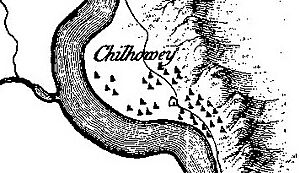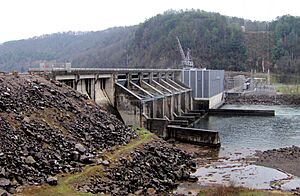Chilhowee (Cherokee town) facts for kids

Chilhowee (Cherokee: ᏧᎷᎾᎢ, romanized: Tsulunawe) was an important Native American site in what is now Blount and Monroe counties in Tennessee. It was located in the Southeastern Woodlands. Today, the original site is underwater, covered by Chilhowee Lake. This lake was created by building a dam on the Little Tennessee River.
In the 1700s, Chilhowee was a large Overhill Cherokee town. Before that, it might have been an older Creek village called "Chalahume." The Spanish explorer Juan Pardo visited this area in 1567. Later, the Cherokee people moved the Creek tribe out of this region.
Euro-American settlers destroyed Chilhowee in the late 1700s during conflicts with the Cherokee. However, the name "Chilhowee" is still used today for many places in East Tennessee. This includes the Chilhowee Dam and its lake, a mountain, and even a park in Knoxville.
Contents
Where Was Chilhowee?
The Little Tennessee River flows into Tennessee from the south. It travels about 54 miles (87 km) northwest through Blount, Monroe, and Loudon counties. Then, it joins the Tennessee River near Lenoir City.
Chilhowee Dam was finished in 1957 by the Aluminum Company of America. It is about 34 miles (55 km) upstream from where the Little Tennessee River meets the Tennessee River. The dam created Chilhowee Lake. This lake stretches for about 10 miles (16 km) between Chilhowee Dam and Calderwood Dam.
Before the area was flooded, the Chilhowee site was on a bend in the Little Tennessee River. It was across from where Abrams Creek flows into the river. You can see the site's general area southeast of the meeting point of U.S. Route 129 and Foothills Parkway.
The Chilhowee site is in a special area where the Appalachian Mountains meet rolling hills. The Great Smoky Mountains are to the northeast, and the Unicoi Mountains are to the south. Chilhowee Lake forms part of the border between the Great Smoky Mountains National Park and the Cherokee National Forest.
Chilhowee's Past
The Village of Chalahume
In late 1567, Spanish explorer Juan Pardo and his team entered the upper Tennessee Valley. This area was then home to part of the Chiaha chiefdom. Pardo followed the Pigeon River to where it met the French Broad River. This is near modern Newport.
The expedition rested at the Chiaha capital called Olamico. Historians believe Olamico was on Zimmerman's Island, which is now underwater due to Douglas Lake. On October 13, Pardo left Olamico. He traveled southwest across the foothills of the Great Smoky Mountains.
On October 15, Pardo's group reached Chalahume in the Little Tennessee Valley. They crossed Little River near modern Walland and went through Happy Valley. Juan de la Bandera, who wrote about the expedition, said Chalahume looked like the Spanish city of Córdoba. He described it as a valley full of grapevines at the base of tall mountains. This description fits the Chilhowee area well.
The Cherokee language does not often use the "m" sound. When the Cherokee people moved into the area, they kept the name Chalahume but changed the "m" to a "w." This is how Chalahume became Chilhowee.
The Cherokee Era
The Cherokee word Chilhowee might be related to their word for "kingfisher." Another idea is that it's the Cherokee way of saying the older Muskogean name Chalahume.
Chilhowee was not mentioned in records until the mid-1700s. However, nearby towns like Citico and Tallassee were known earlier. In 1725, Colonel George Chicken visited the Overhill towns. He wanted to form an alliance against the Creek (Muscogee) tribe. He met with leaders from Tanasi, Citico, Tallassee, Great Tellico, and "Coosaw."
In 1761, Henry Timberlake visited Chilhowee on a peace mission. He took part in a pipe-smoking ceremony with the town's leaders. Timberlake's map, called Draught of the Cherokee Country (1762), showed Chilhowee with 18 homes and a townhouse. He listed Yachtino as the town's headman. Timberlake also noted that 110 warriors lived there. This made Chilhowee's fighting force the third largest among the Overhill towns.
In the 1770s, more Euro-American settlers moved into the Tennessee Valley. This led to more conflicts with the Cherokee people. Around this time, Old Abraham, the leader of Chilhowee, became very important among the Overhill Cherokee.
During the American Revolutionary War in 1776, the Cherokee sided with the British. Old Abraham, The Raven, and Dragging Canoe led attacks against rebel camps. However, these attacks were not successful for the Native Americans.
Virginia sent Colonel William Christian to stop the Overhill towns. Christian entered the Little Tennessee Valley without a fight. He made a truce with some older chiefs. But Dragging Canoe refused to make peace. So, Christian burned several Overhill towns, including Chilhowee.
In 1788, Old Abraham and other chiefs were attacked and killed. This happened under a flag of truce by the son of John Kirk. Kirk's family had been killed by members of the Cherokee militant factions.
Later Years: 1800s and 1900s
Around 1850, two brothers, William and Robert James, built a cotton and woolen mill. It was located at the mouth of Abrams Creek. The mill used power from the creek to make fabric. The mill closed when the American Civil War began.
The Cherokee National Forest was created in 1911. It now protects the western shore above Chilhowee Lake. The Great Smoky Mountains National Park was established in 1932. It protects the eastern shore. Abrams Creek, the longest stream entirely within the park, is named after Old Abraham of Chilhowee. There is a campground and ranger station along the creek, a few miles upstream from Chilhowee.
In 1955, Alcoa announced plans to build Chilhowee Dam. The Knoxville Chapter of the Tennessee Archaeological Society decided to dig for artifacts at the Chilhowee site and the Tallassee site. Both sites would be flooded by the new lake. They focused more on Tallassee because it had more surface materials and was easier to reach. They did only limited collecting at Chilhowee.




